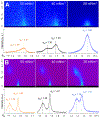Structural Changes in Films of Pulmonary Surfactant Induced by Surfactant Vesicles
- PMID: 33080138
- PMCID: PMC8754419
- DOI: 10.1021/acs.langmuir.0c01813
Structural Changes in Films of Pulmonary Surfactant Induced by Surfactant Vesicles
Abstract
When compressed by the shrinking alveolar surface area during exhalation, films of pulmonary surfactant in situ reduce surface tension to levels at which surfactant monolayers collapse from the surface in vitro. Vesicles of pulmonary surfactant added below these monolayers slow collapse. X-ray scattering here determined the structural changes induced by the added vesicles. Grazing incidence X-ray diffraction on monolayers of extracted calf surfactant detected an ordered phase. Mixtures of dipalmitoyl phosphatidylcholine and cholesterol, but not the phospholipid alone, mimic that structure. At concentrations that stabilize the monolayers, vesicles in the subphase had no effect on the unit cell, and X-ray reflection showed that the film remained monomolecular. The added vesicles, however, produced a concentration-dependent increase in the diffracted intensity. These results suggest that the enhanced resistance to collapse results from enlargement by the additional material of the ordered phase.
Conflict of interest statement
The authors declare no competing financial interest.
Figures



Similar articles
-
Suppression of Lα/Lβ Phase Coexistence in the Lipids of Pulmonary Surfactant.Biophys J. 2021 Jan 19;120(2):243-253. doi: 10.1016/j.bpj.2020.12.008. Epub 2020 Dec 19. Biophys J. 2021. PMID: 33347885 Free PMC article.
-
Structural determinants of collapse by a monomolecular mimic of pulmonary surfactant at the physiological temperature.Soft Matter. 2024 Jul 24;20(29):5745-5753. doi: 10.1039/d4sm00481g. Soft Matter. 2024. PMID: 38982765
-
Effects of cholesterol on the structure and collapse of DPPC monolayers.Biophys J. 2022 Sep 20;121(18):3533-3541. doi: 10.1016/j.bpj.2022.07.007. Epub 2022 Jul 14. Biophys J. 2022. PMID: 35841141 Free PMC article.
-
The biophysical function of pulmonary surfactant.Respir Physiol Neurobiol. 2008 Nov 30;163(1-3):244-55. doi: 10.1016/j.resp.2008.05.018. Epub 2008 Jul 16. Respir Physiol Neurobiol. 2008. PMID: 18632313 Free PMC article. Review.
-
Pulmonary surfactant: phase behavior and function.Curr Opin Struct Biol. 2002 Aug;12(4):487-94. doi: 10.1016/s0959-440x(02)00352-4. Curr Opin Struct Biol. 2002. PMID: 12163072 Review.
Cited by
-
The biophysical function of pulmonary surfactant.Biophys J. 2024 Jun 18;123(12):1519-1530. doi: 10.1016/j.bpj.2024.04.021. Epub 2024 Apr 25. Biophys J. 2024. PMID: 38664968 Free PMC article. Review.
-
Respiratory Health Impacts from Natural Disasters and Other Extreme Weather Events: The Role of Environmental Stressors on Asthma and Allergies.Curr Allergy Asthma Rep. 2025 May 21;25(1):25. doi: 10.1007/s11882-025-01206-9. Curr Allergy Asthma Rep. 2025. PMID: 40397190 Review.
-
Surfactant protein SP-B: one ring to rule the molecular and biophysical mechanisms of the pulmonary surfactant system.Biophys Rev. 2025 Mar 18;17(2):653-666. doi: 10.1007/s12551-025-01285-y. eCollection 2025 Apr. Biophys Rev. 2025. PMID: 40376411 Review.
-
Suppression of Lα/Lβ Phase Coexistence in the Lipids of Pulmonary Surfactant.Biophys J. 2021 Jan 19;120(2):243-253. doi: 10.1016/j.bpj.2020.12.008. Epub 2020 Dec 19. Biophys J. 2021. PMID: 33347885 Free PMC article.
-
Comparative biophysical study of clinical surfactants using constrained drop surfactometry.Am J Physiol Lung Cell Mol Physiol. 2024 Oct 1;327(4):L535-L546. doi: 10.1152/ajplung.00058.2024. Epub 2024 Aug 19. Am J Physiol Lung Cell Mol Physiol. 2024. PMID: 39159363
References
-
- Goerke J; Clements JA Alveolar surface tension and lung surfactant. In Handbook of Physiology—The Respiratory System Vol III, Part 1; Macklem PT, Mead J, Ed.; American Physiological Society: Washington, D.C., 1985; Vol. III, pp 247–261.
-
- Bastacky J; Lee CY; Goerke J; Koushafar H; Yager D; Kenaga L; Speed TP; Chen Y; Clements JA Alveolar lining layer is thin and continuous: low-temperature scanning electron microscopy of rat lung. J. Appl. Physiol 1995, 79, 1615–1628. - PubMed
-
- Fisher MJ; Wilson MF; Weber KC Determination of alveolar surface area and tension from in situ pressure-volume data. Respir. Physiol 1970, 10, 159–171. - PubMed
-
- Horie T; Hildebrandt J Dynamic compliance, limit cycles, and static equilibria of excised cat lung. J. Appl. Physiol 1971, 31, 423–430. - PubMed
Publication types
MeSH terms
Substances
Grants and funding
LinkOut - more resources
Full Text Sources

